| |
ENVIS Technical Report: 43, February 2012 |
 |
ECOLOGICAL STATUS OF DANDELI ANSHI TIGER RESERVE |
 |
Energy and Wetlands Research Group, Centre for Ecological Sciences,
Indian Institute of Science, Bangalore – 560012, India.
*Corresponding author: cestvr@ces.iisc.ac.in
|
|
FISH
Parameters to be considered:
- Stream orders – first order, second order, 3rd order, etc.,
- Nature of Catchment area -
- Terrain of the surrounding region – plain, hilly, coastal, etc.,
- Micro-habitat conditions – Riparian forest, canopy cover, substrate type, dimensions of the water body, flow,
- Perennial, intermittent streams
- Effluent discharge
Seasonal Sampling: Seasonal variation in species occurrence and composition can be seen. Hence, sampling across the seasons is necessary to get the complete picture. Moreover, in each sampling event repeated daily sampling will yield the best results.
Sampling Time: Early morning or late evening is the ideal time for fish sampling
Sampling Types:
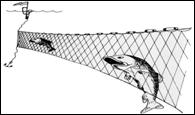 a). Gill net sampling: This is the appropriate sampling method for moderately deep pools. Fishes are trapped through their gills in the net. One has to use sufficient reasoning to choose the mesh size of the net to trap appropriate fishes. This reasoning has to come from size of the water body. On the other hand, gill nets with varying mesh sizes can also be effective. a). Gill net sampling: This is the appropriate sampling method for moderately deep pools. Fishes are trapped through their gills in the net. One has to use sufficient reasoning to choose the mesh size of the net to trap appropriate fishes. This reasoning has to come from size of the water body. On the other hand, gill nets with varying mesh sizes can also be effective.
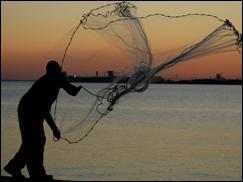 b). Cast net sampling: This is the appropriate sampling method for shallow water bodies. However, art of using cast net is essential to use the net effectively. b). Cast net sampling: This is the appropriate sampling method for shallow water bodies. However, art of using cast net is essential to use the net effectively.
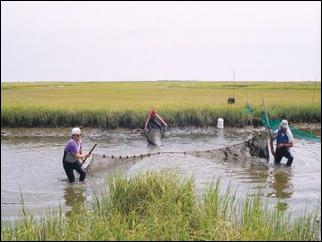 c). Drag net sampling: One of the most effective sampling techniques in shallow and small pools, wherein, the net is dragged to sweep out the fishes of the water body. Although this technique is effective, this results in massive destruction of the fish communities and hence should be carefully c). Drag net sampling: One of the most effective sampling techniques in shallow and small pools, wherein, the net is dragged to sweep out the fishes of the water body. Although this technique is effective, this results in massive destruction of the fish communities and hence should be carefully 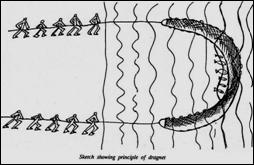 used. used.
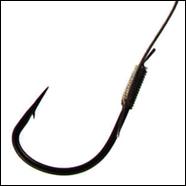
d). Hooks and lines:
For large carnivorous fishes, hooks and lines should be used for sampling. Especially in deep and rocky pools this method is effective to capture such fishes.
e). Opportunistic sampling in streams and rivers using unconventional methods: Several methods are available for opportunistic sampling that ranges from observation using naked eye till using cloths for sweeping the water bodies. However, one should avoid using destructive fishing methods such as poisoning, use of explosives, etc.
Some tips to locate the fishes in water:
- Swampy pools are known for air-breathing fishes
- Deep pools with clear water and rocky substrate are known for Mahaseers/huge carnivorous fishes, etc.,
- Perennial streams amidst the forests are known for some pristine and rare fishes that are known for Western Ghats only (endemic fishes)
- Torrential streams/step falls can be targeted for free flowing active fishes which have flat and wide pectoral fins. Ex: Garra, Parapsilorhynchus, Homaloptera fishes etc.
|
|
|
T.V. Ramachandra
Centre for Sustainable Technologies,
Centre for infrastructure, Sustainable Transportation and Urban Planning (CiSTUP),
Energy & Wetlands Research Group, Centre for Ecological Sciences, Indian Institute of Science, Bangalore – 560 012, INDIA.
E-mail : cestvr@ces.iisc.ac.in
Tel: 91-080-22933099/23600985,
Fax: 91-080-23601428/23600085
Web: http://ces.iisc.ac.in/energy
Subash Chandran M.DEnergy & Wetlands Research Group, Centre for Ecological Sciences, Indian Institute of Science, Bangalore – 560 012, INDIA.
E-mail:
mds@ces.iisc.ac.in
Rao G.R
Energy & Wetlands Research Group, Centre for Ecological Sciences, Indian Institute of Science, Bangalore – 560 012, INDIA.
E-mail:
grrao@ces.iisc.ac.in
Amit Yadav
Energy & Wetlands Research Group, Centre for Ecological Sciences, Indian Institute of Science, Bangalore – 560 012, INDIA.
Gururaja KV
Energy & Wetlands Research Group, Centre for Ecological Sciences, Indian Institute of Science, Bangalore – 560 012, INDIA.
E-mail:
gururaj@ces.iisc.ac.in
Karthick B
Energy & Wetlands Research Group, Centre for Ecological Sciences, Indian Institute of Science, Bangalore – 560 012, INDIA.
E-mail:
karthick@ces.iisc.ac.in
Uttam Kumar
Energy & Wetlands Research Group, Centre for Ecological Sciences, Indian Institute of Science, Bangalore – 560 012, INDIA.
E-mail:
uttam@ces.iisc.ac.in
Durga Madhab Mahapatra
Energy & Wetlands Research Group, Centre for Ecological Sciences, Indian Institute of Science, Bangalore – 560 012, INDIA.
E-mail:
durgamadhab@ces.iisc.ac.in
Vishnu D.M
Energy & Wetlands Research Group, Centre for Ecological Sciences, Indian Institute of Science, Bangalore – 560 012, INDIA.
Citation: Ramachandra. T.V, Subash Chandran M.D, Rao GR, Amit Yadav, Gururaja KV, Karthick B, Uttam Kumar, Durga Madhab Mahapatra and Vishnu D.M, 2012. Ecological status of Dandeli Anshi Tiger Reserve., ENVIS Technical Report : 43, Energy & Wetlands Research Group, Centre for Ecological Sciences, Indian Institute of Science, Bangalore 560 012.
* According to IUCN red data list.
* According to IUCN red data list.